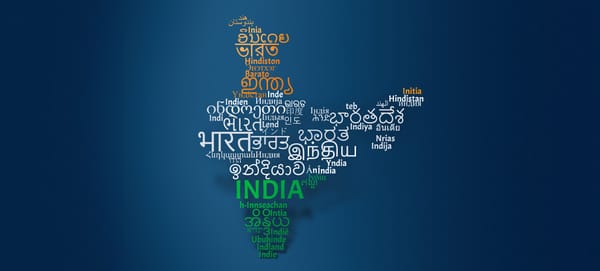Table of contents
I. Introduction to India's Linguistic Diversity
- India's multilingual landscape is a prime example of the country's diversity and heritage, shaped by millennia of migrations and cultural integration.
- This linguistic richness has been a significant strength, though at times, a source of political conflicts.
- The age-old saying, "Kos-kos par badle paani, chaar kos par baani" (The water changes every mile, the speech every fourth), beautifully encapsulates India's linguistic richness.
- In contrast to the Western model of a nation-state, where a dominant language becomes the norm, the Constitution of India established federal principles to encourage and protect a multilingual-multicultural ethos.
- India has served as a model for other linguistically diverse states by embracing cultural-linguistic diversity.

II. Constitutional Provisions Related to Languages
- The Constitution does not list any one language as India's "national language".
- Part XVII of the Constitution of India specifically deals with the official language.
A. Eighth Schedule
- The Eighth Schedule to the Constitution of India lists the official languages of the Republic of India.
- As of May 2025, there are 22 languages included in the Eighth Schedule.
- Initially, the schedule included 14 languages: Assamese, Bengali, Gujarati, Hindi, Kannada, Kashmiri, Malayalam, Marathi, Oriya (renamed to Odia in 2011), Punjabi, Sanskrit, Tamil, Telugu, and Urdu.
- These initial 14 languages were chosen from among the 700 linguistic varieties cataloged by the Linguistic Survey of India by 1927.
- Expansion of the Schedule:
- Sindhi was added through the 21st Amendment Act of 1967.
- Konkani, Manipuri, and Nepali were added by the 71st Amendment Act of 1992 [20, 9(a)].
- Bodo, Dogri, Maithili, and Santhali were included through the 92nd Amendment Act of 2003.
- Criteria for Inclusion:
- The Constituent Assembly did not lay down any formal criteria for the inclusion of languages in the Eighth Schedule.
- Recommendations for such criteria have been made by various committees, including the Ashok Pahwa Committee (1996) and the Sitakant Mohapatra Committee (2003) [22, 11(c)]. Both committees were associated with the Eighth Schedule [11(c)].
- Demands for Inclusion: There are demands to include more than 30 languages in the Eighth Schedule, such as Kokborok, Bhojpuri, Garhwali (Pahari), and Rajasthani.

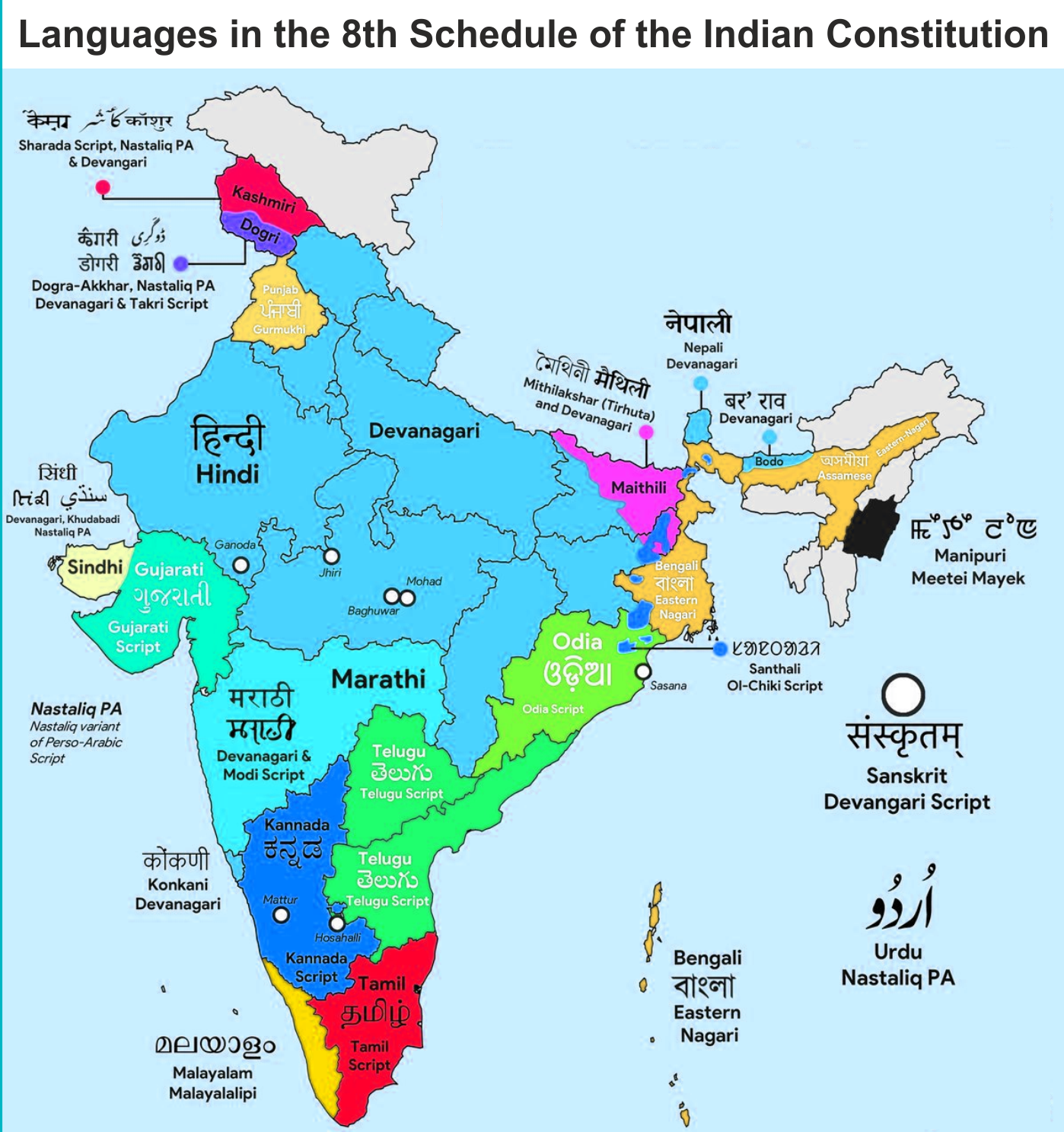
B. Official Language of the Union (Article 343)
- Hindi in Devanagari script is the official language of the Union.
- The numerals to be used are the international form of Indian numerals.
- For a period of 15 years from the commencement of the Constitution (January 26, 1950), the English language was to continue for all official purposes.
- Under Article 343(3), Parliament could legislate to continue the use of English after this 15-year period.
C. Commission and Committees on Official Language (Article 344)
- Article 344(1) provides for the constitution of a Commission on Official Language after five years from the commencement of the Constitution, and subsequently after the expiration of ten years from such commencement.
- This Commission is to consist of a Chairman and other members representing the different languages of India.
D. Official Language(s) of a State (Article 345)
- Subject to Articles 346 and 347, the Legislature of a State may by law adopt any one or more of the languages in use in the State or Hindi as the official language(s) for all or any of the official purposes of that State.
E. Language for Redress of Grievances (Article 350)
- Every person is entitled to submit a representation for the redress of any grievance to any officer or authority of the Union or a State in any language used in the Union or in the State, as the case may be.
F. Facilities for Instruction in Mother Tongue at Primary Stage (Article 350A)
- Every State and local authority within the State must endeavor to provide adequate facilities for instruction in the mother-tongue at the primary stage of education to children belonging to linguistic minority groups.
- The President may issue necessary directions to any State to ensure the provision of such facilities.
G. Special Officer for Linguistic Minorities (Article 350B)
- The Constitution mandates the appointment of a Special Officer for Linguistic Minorities.
- The officer's duty is to investigate all matters relating to the safeguards provided for linguistic minorities under the Constitution and report to the President.
- These reports are then laid before each House of Parliament and sent to the Governments of the States concerned.
H. Directive for Development of Hindi Language (Article 351)
- It is the duty of the Union to promote the spread of the Hindi language and develop it to serve as a medium of expression for all elements of the composite culture of India.
- This must be done "without interfering with its genius, the forms, style and expressions" of other languages.
Mindmap
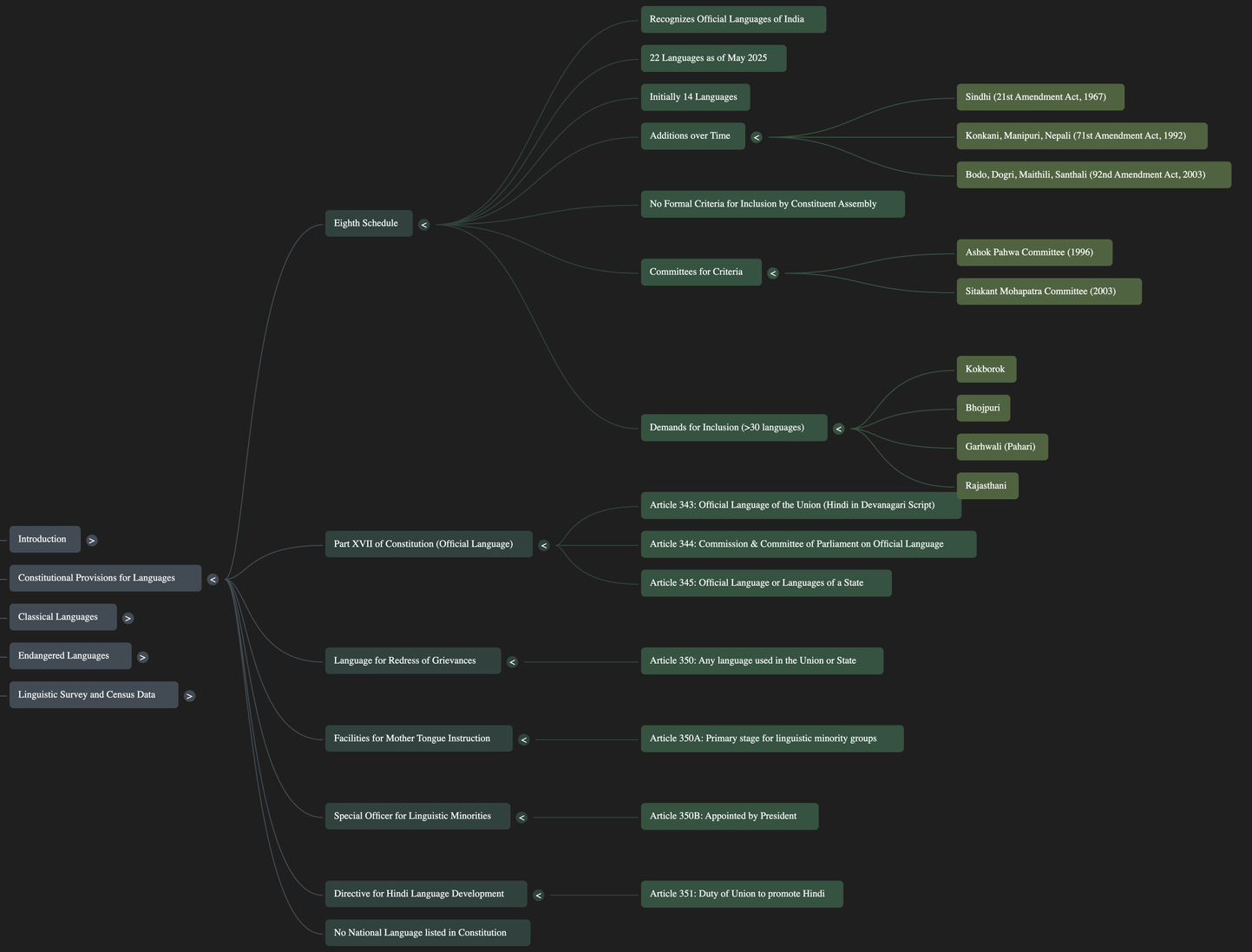
III. Classical Languages of India
- Classical languages are considered custodians of India’s ancient and profound cultural heritage, preserving the rich history, literature, and traditions of their respective communities.
- The government grants this status to honor and safeguard the linguistic milestones of India’s diverse cultural landscape.
Initiation of Classical Language Status:
- The Centre decided to create a new category of "classical languages" in October 2004.
- Initially, the Ministry of Tourism and Culture granted classical status to Tamil and Sanskrit.
- Later, the Ministry of Culture assumed responsibility for further implementations and future recognition.
Linguistic Experts Committee (LEC):
- Constituted by the Ministry of Culture under the Sahitya Akademi in November 2004 to examine the eligibility of languages proposed for classical language status.
- On July 25, 2024, the LEC revised the criteria and recommended Marathi, Pali, Prakrit, Assamese, and Bengali for classical language status.
- These recommended languages were granted ‘Classical Language’ status in October last year.
Key Criteria for Classical Language Status:
- High antiquity of texts/recorded history over a period of 1500-2000 years.
- A body of ancient literature/texts, considered a heritage by generations of speakers.
- Original literary tradition, not borrowed from another speech community.
- Knowledge texts, including prose texts, epigraphic, and inscriptional evidence.
- The classical language and literature could be distinct from its current form or discontinuous with later forms.
List of Classical Languages and Year of Status Grant:
- Tamil (2004)
- Sanskrit (2005)
- Kannada (2008)
- Telugu (2008)
- Malayalam (2013)
- Odia (2014)
- Marathi, Pali, Prakrit, Assamese, and Bengali (granted status in October last year, based on July 25, 2024, LEC recommendation).


Descriptions of Newly Added Classical Languages:
- Marathi: Modern Marathi descends from Maharashtri Prakrit, with oldest evidence from the 1st century BCE. Earliest evidence of modern Marathi dates to 739 CE.
- Bengali & Assamese: These are Eastern Indo-Aryan languages. Their emergence is contested, with scholars suggesting dates between the 6th and 12th centuries. They took on a recognizable form well into the second millennium CE.
- Prakrit: This term refers to a group of closely-related Indo-Aryan languages. They were considered the language of the masses, unlike Sanskrit which was restricted to elites and high literature. They were also the vernaculars of popular heterodox religions like Buddhism and Jainism.
- Pali: Closely associated with Buddhism and known as the language of the Theravada Buddhist canon, the Tipitaka. Some modern scholars believe it to be a mix of several Prakrit languages, partially Sanskritised.
- Relationship with Eighth Schedule: Notably, Prakrit and Pali are two classical languages that are not mentioned in the Eighth Schedule of the Indian Constitution.
Importance of Classical Language Status:
- Elevates their stature and promotes their growth.
- Encourages research and ensures their continued relevance.
- Aids in addressing contemporary challenges like digitalization and globalization.
- Expected to boost language-related academics and research.
- The tasks of preservation, documentation, and digitisation of ancient texts will likely generate jobs in archiving, translation, publishing, and digital media.
Mindmap
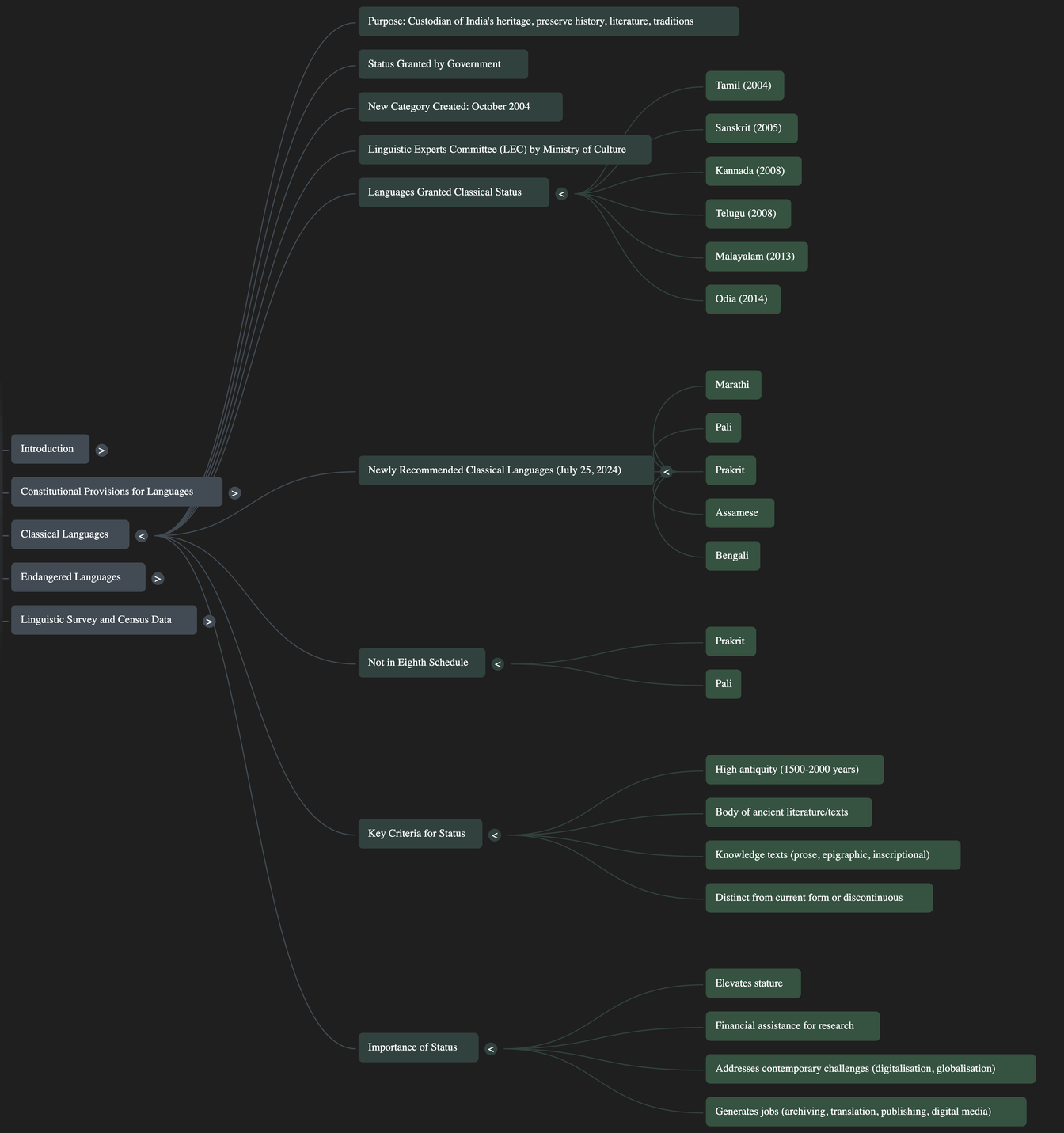
IV. Endangered Languages
- The extinction of each language causes a permanent loss of distinctive ecological, historical, and cultural knowledge.
- According to Dr. K Sreenivasarao (Secretary of the Sahitya Akademi), the loss of languages equates to the loss of culture.
Definition/Characteristics of Endangered Languages:
- Languages spoken by fewer than 10,000 speakers or languages that have not been linguistically documented are considered endangered or likely to be endangered.
- According to UNESCO, any language spoken by less than 10,000 people is potentially endangered.
- Experts note that endangered languages see an increasingly reduced number of communicative domains and cease to be passed on from one generation to the next, meaning there are no new speakers, adults or children.
- Categories of Endangerment (UNESCO): Vulnerable, Definitely Endangered, Severely Endangered, and Critically Endangered.
- Global Statistics: Nearly 40% of the world’s 7,000 languages, including dialects of indigenous people groups, have already disappeared, with several others on the verge of extinction.


Endangered Languages in India:
- Literary critic Ganesh Narayan Devy states that after the 1971 census, the Indian government decided that any language spoken by less than 10,000 people was not worthy of mention.
- Based on his survey, there are close to 780 languages in India, out of which about 600 are potentially endangered.
- The 1991 and 2001 censuses only accounted for not more than 122 languages, implying most others are potentially endangered.
- About 250 languages disappeared in India in the last 60 years.
- Examples of endangered languages:
- Nomadic people's languages: Wadari, Kolhati, Golla, Gisari (in Maharashtra, Karnataka, Telangana).
- Tribal languages: Pauri, Korku, Haldi, Mavchi.
- Assam languages: Moran, Tangsa, Aiton.
- Examples of recently disappeared languages:
- Bo language in Andaman (disappeared in 2010).
- Majhi language in Sikkim (disappeared in 2015).
- Ganesh Devy emphasizes that "A language is not a single life system. It is a very large symbolic system. When the symbols collapse they do not do so in a single moment. The collapse is sprayed over a large time".
Mindmap
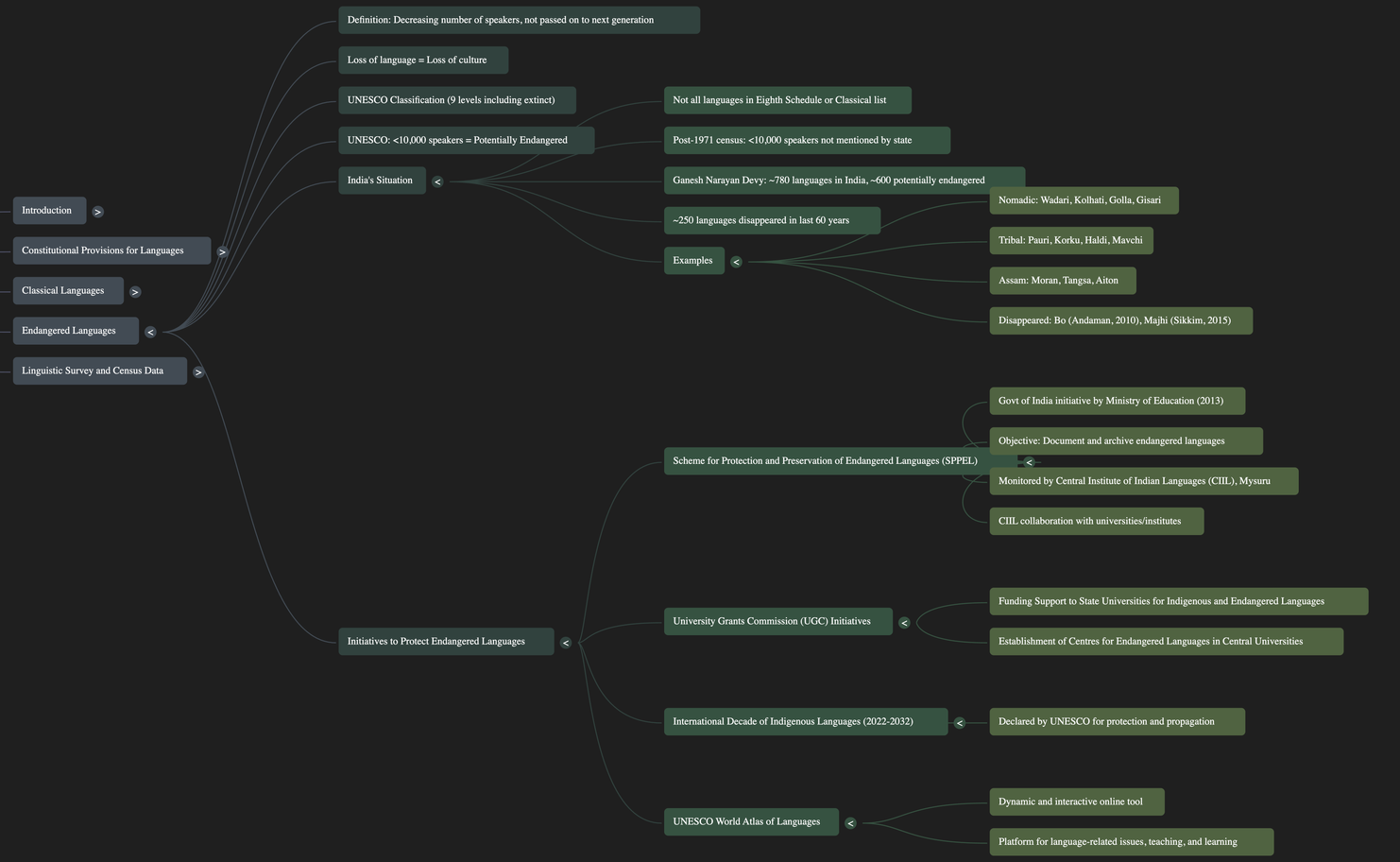
V. Initiatives for Protection of Endangered Languages
- The Constitution of India states that any citizen residing in India having a distinct language, script, or culture has the right to conserve the same.
- Initiatives are in place at both national and global levels.
A. Scheme for Protection and Preservation of Endangered Languages (SPPEL)
- Instituted by the Ministry of Education (Government of India) in 2013.
- Objective: To document and archive the country’s languages that have become endangered or are likely to be endangered in the near future.
- Monitoring and Collaboration: The scheme is monitored by the Central Institute of Indian Languages (CIIL) located in Mysuru, Karnataka. CIIL has collaborated with various universities and institutes across India for this mission.
- The scheme focuses on languages spoken by fewer than 10,000 speakers or those not yet linguistically documented.



B. Initiatives of the University Grants Commission (UGC)
- The UGC has initiated two schemes for the protection of endangered languages:
- ‘Funding Support to the State Universities for Study and Research in Indigenous and Endangered Languages in India’.
- ‘Establishment of Centres for Endangered Languages in Central Universities’.


C. International Decade of Indigenous Languages (2022-2032)
- UNESCO has declared the years between 2022 and 2032 as the International Decade of Indigenous Languages for their protection and propagation.

D. UNESCO World Atlas of Languages
- This is a dynamic and interactive online tool, constantly updated by users.
- It serves as a global overview of languages, a repository for information on language-related issues, and an interactive tool for language teaching and learning.

VI. Linguistic Surveys and Census Data
- The Linguistic Survey of India: Conducted by Sir George Abraham Grierson between 1901 and 1928. This survey cataloged over 700 linguistic varieties across the subcontinent by 1927.
- 2011 Linguistic Census: Accounts for 121 mother tongues, including the 22 languages listed in the 8th Schedule of the Constitution.
- Hindi is the most widely spoken, declared as mother tongue by 52.8 crore individuals, or 43.6% of the population.
- Bengali is the next highest, with 9.7 crores (8%) declaring it as their mother tongue.
Mindmap


Sources: Articles from The Indian Express, Wikipedia, MyGov.in
Note: Image credits to respective owners.

Courses by UPSCprep.com
A comprehensive range of courses meticulously designed to help you cover the syllabus in phases, without overwhelming you with long classes, ensuring you have ample time for self-study.
